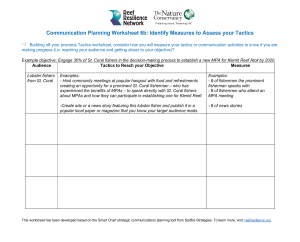Measurement
Step 6: Measure Your Impact
Evaluation will show you whether you need to make changes or adjustments to achieve your goal and when (or if) you’ve reached your objective.
Watch a short presentation about measuring your impact:
When to Measure
Measurement should begin before your communications strategy is implemented. The good news is, you started some preliminary measurement in Steps 2 and 3 when you assessed your context and started examining your audiences. That initial data can serve as your starting point – which is important because you can’t measure where you end without knowing where you started.
Don’t wait until the end of your project to collect and review statistics. Collecting data as you go will help you learn what works and what doesn’t, so you can revise your approach as needed. If your strategy of reaching a specific audience with a message and getting them to take action is not working, the sooner you know, the sooner you can make changes so you can reach your goal.
At a minimum, you should evaluate at least once, approximately midway through your project timeline, and then again at the end. Interim measurements can also be motivating to share with people around you such as staff and volunteers, with your target audiences who are supporters, and with managers, funders, or other important allies. Measuring the effect of your project, even if you didn’t achieve your goal, will help improve future projects, and enable you to use limited resources more effectively next time.
What to Measure
When thinking about what to measure consider:
- Did your message reach your target audience? How much of your target audience did you reach?
- Did your target audience respond to your message? If not, does your message need to be changed?
- How has the behavior of your audience changed?
- Did you convert new supporters or develop new relationships?
- Did you achieve your goal and how do you know?
- How much money did you spend, and what were the results?
- If you used a tactic for the first time, how did it perform? Would you use it again? Modify it?
- If you made a significant investment in a tactic, how did it perform? Can you assess if the investment was worth it?
Types of Measures
Outputs are the things you do – actions you take – to move your strategy forward. For example, if you are encouraging people to buy and use yard products that are less harmful to the ocean and you stickered products to alert customers which products to buy, one project output could be “labeled 1,000 bottles of fertilizer ‘Ocean Preferred’.” If you host events, you can track the number of people who attend or the number of brochures handed out.
Outcomes are the changes that occur because of your efforts, such as a change in awareness, attitude, or behavior, or a new policy or law. For example, “sold 1,000 bottles of fertilizer ‘Ocean Preferred’.”
Most outputs are relatively easy to measure and are often quantifiable - something that can be counted. Outcomes may or may not be countable, but can be anecdotal, such as a personal observation or story. One example is a quote from a hardware store customer sharing how the ocean-preferred stickers influenced their behavior: “I was debating about what fertilizer to buy and I noticed a sticker that read ‘Ocean Preferred.’ It was the deciding factor in my purchase.”
Anecdotal information is powerful in telling a story, and when used in conjunction with numbers and stats makes your project results personable, showing the faces behind the numbers.
Measuring outcomes is trickier. You can measure outcomes by working backwards from your objective. For example, if your goal was to get people not to litter, you could measure the amount of litter on a beach monthly before your project started, then measure the amount of litter during and afterwards to see if the amount of litter decreased.
A strategy that has a mix of output and outcome measures, both quantifiable and anecdotal, can result in a more accurate and compelling evaluation.
Test Your Understanding
Test your understanding of the information in this section by taking the quiz.
Your Turn (> 20 minutes recommended)
- Using the Tactics Worksheet, write down the kinds of measures you will use to assess your tactics. If you can’t measure a tactic, make note of this.
- Once you have filled out the worksheet, review your list of measures. For the tactics that can’t be measured, how important are they to reaching your objective? If they aren’t important and can’t be measured, they should probably be cut from the plan. (Conserve resources when possible!)
- Decide if any tactics can be cut.
Guiding questions:
- Will your outputs and outcomes show whether you have made progress towards achieving your objective? Do you have measures you can count?
- Is data available to track these measurements?
- Have you considered free online tools such as Facebook tracking or Google Analytics?
- Have you included a measure to collect anectodal results, such as informal interviews?
- Are your measurements a mix of outputs and outcomes, both quantifiable and anecdotal?
Have you included measurements that can be reviewed throughout your communications effort, and not just at the end?
This worksheet is based on Spitfire Strategies’ Smart Chart® strategic communications planning tool. The Smart Chart is a registered trademark of Spitfire Strategies. To learn more, visit: spitfirestrategies.com.

